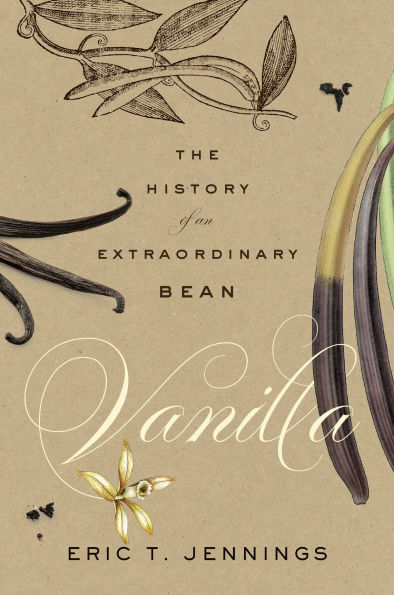The fascinating and wide-ranging history of vanilla, from the sixteenth century to today
Vanilla is one of the most expensive of flavorings—so valuable that it was smuggled or stolen by pirates in the early days—and yet it is everywhere. It is a key ingredient in dishes ranging from crème brûlée to Japanese purin. It is the quintessential ice cream flavor in the United States. Eric T. Jennings explains how the world’s only edible orchid, originally endemic to Central America, became embedded in the international culinary and cultural landscape.
In tracing vanilla’s rise, Jennings describes how in the 1840s an enslaved boy named Edmond Albius discovered a way to pollinate vanilla orchids with a toothpick or needle—an ingenious process that is still in use. This method transformed the vanilla sector by enabling the plant to be grown outside of its natural range. Jennings also looks at how the vanilla craze led to the search for now‑pervasive substitutes, and how a vanilla lobby has fought back. He further unravels how vanilla—the world’s most expensive crop and once considered its most refined fragrance—came to mean “bland.”
This tale of botany, production techniques, consumption habits, and colonial rivalry connects the Atlantic, Indian, and Pacific Oceans, revealing how vanilla has become a potent symbol of the modern global village.
1146468797
Vanilla is one of the most expensive of flavorings—so valuable that it was smuggled or stolen by pirates in the early days—and yet it is everywhere. It is a key ingredient in dishes ranging from crème brûlée to Japanese purin. It is the quintessential ice cream flavor in the United States. Eric T. Jennings explains how the world’s only edible orchid, originally endemic to Central America, became embedded in the international culinary and cultural landscape.
In tracing vanilla’s rise, Jennings describes how in the 1840s an enslaved boy named Edmond Albius discovered a way to pollinate vanilla orchids with a toothpick or needle—an ingenious process that is still in use. This method transformed the vanilla sector by enabling the plant to be grown outside of its natural range. Jennings also looks at how the vanilla craze led to the search for now‑pervasive substitutes, and how a vanilla lobby has fought back. He further unravels how vanilla—the world’s most expensive crop and once considered its most refined fragrance—came to mean “bland.”
This tale of botany, production techniques, consumption habits, and colonial rivalry connects the Atlantic, Indian, and Pacific Oceans, revealing how vanilla has become a potent symbol of the modern global village.
Vanilla: The History of an Extraordinary Bean
The fascinating and wide-ranging history of vanilla, from the sixteenth century to today
Vanilla is one of the most expensive of flavorings—so valuable that it was smuggled or stolen by pirates in the early days—and yet it is everywhere. It is a key ingredient in dishes ranging from crème brûlée to Japanese purin. It is the quintessential ice cream flavor in the United States. Eric T. Jennings explains how the world’s only edible orchid, originally endemic to Central America, became embedded in the international culinary and cultural landscape.
In tracing vanilla’s rise, Jennings describes how in the 1840s an enslaved boy named Edmond Albius discovered a way to pollinate vanilla orchids with a toothpick or needle—an ingenious process that is still in use. This method transformed the vanilla sector by enabling the plant to be grown outside of its natural range. Jennings also looks at how the vanilla craze led to the search for now‑pervasive substitutes, and how a vanilla lobby has fought back. He further unravels how vanilla—the world’s most expensive crop and once considered its most refined fragrance—came to mean “bland.”
This tale of botany, production techniques, consumption habits, and colonial rivalry connects the Atlantic, Indian, and Pacific Oceans, revealing how vanilla has become a potent symbol of the modern global village.
Vanilla is one of the most expensive of flavorings—so valuable that it was smuggled or stolen by pirates in the early days—and yet it is everywhere. It is a key ingredient in dishes ranging from crème brûlée to Japanese purin. It is the quintessential ice cream flavor in the United States. Eric T. Jennings explains how the world’s only edible orchid, originally endemic to Central America, became embedded in the international culinary and cultural landscape.
In tracing vanilla’s rise, Jennings describes how in the 1840s an enslaved boy named Edmond Albius discovered a way to pollinate vanilla orchids with a toothpick or needle—an ingenious process that is still in use. This method transformed the vanilla sector by enabling the plant to be grown outside of its natural range. Jennings also looks at how the vanilla craze led to the search for now‑pervasive substitutes, and how a vanilla lobby has fought back. He further unravels how vanilla—the world’s most expensive crop and once considered its most refined fragrance—came to mean “bland.”
This tale of botany, production techniques, consumption habits, and colonial rivalry connects the Atlantic, Indian, and Pacific Oceans, revealing how vanilla has become a potent symbol of the modern global village.
30.0
Pre Order
5
1

Vanilla: The History of an Extraordinary Bean
288
Vanilla: The History of an Extraordinary Bean
288Related collections and offers
30.0
Pre Order

Product Details
| ISBN-13: | 9780300283525 |
|---|---|
| Publisher: | Yale University Press |
| Publication date: | 08/26/2025 |
| Sold by: | Barnes & Noble |
| Format: | eBook |
| Pages: | 288 |
| File size: | 17 MB |
| Note: | This product may take a few minutes to download. |
About the Author
From the B&N Reads Blog
